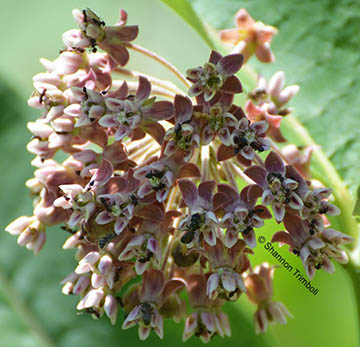We often think of all bees, butterflies, and other insect visitors to flowers as pollinators, especially if we see them actively gathering pollen or drinking nectar. However, that’s not actually true. Not everything that visits a flower is a pollinator for that species of flower.
Pollinators are animals (usually insects in the eastern U.S.) that assist in the pollination of a plant by moving pollen from one flower to another. Many insects that don’t assist in pollination, and therefore aren’t pollinators, will often visit a flower to drink nectar or feed on the pollen. Some insects are also pollinators for some species of flowers that they visit, but not for all the flower species that they visit.

For example, grasses (including corn), ragweed, and many other types of plants are wind pollinated. This means they rely on the wind to blow their pollen to where it needs to be. To increase the chances of the plant’s pollen landing on another flower of the right type, these plants produce tons of pollen. (Anyone who has spring or fall allergies or has parked under a pine tree in the spring can attest to the amount of pollen these plants produce.) However honey bees, and sometimes other insects, will visit these wind pollinated plants. When they do, they aren’t serving as pollinators, but are simply taking advantage of an abundant free meal represented by all of the pollen these plants are producing.
Many other flowers rely on insects, or other animals, for pollination. Yet, even these plants are often visited by animals that drink the flower’s nectar and feed on its pollen, but don’t participate in its pollination. For example, visit a large patch of milkweed in the spring and you will find lots of different species of bees, butterflies, wasps, flies, ants, beetles, and maybe even a few species of moths. Some of the species of bees, butterflies, wasps, etc. will be larger and some smaller. However, many of those flower visitors aren’t milkweed pollinators.
Milkweeds have a very specialized method of pollination and the primary milkweed pollinators are larger bees, wasps, and occasionally a few larger species of butterflies and moths. Smaller insects aren’t capable of moving the pollen from one flower to the next. (Honey bees are some of the smallest species of bees that are capable of pollinating milkweed.) The rest of the insects visiting the milkweed flowers are simply taking advantage of the resources that are available without moving pollen from one flower to the next. Similar stories could be told about most of our animal pollinated flowers. Like so many other things in nature, the roles between flowers and the insects or other animals that visit those flowers is often much more complicated than we give them credit for.

This article was part of Shannon’s original Kentucky Pollinators and Backyard Wildlife blog which evolved into the blog for Backyard Ecology.

Backyard Ecology: Exploring Nature in Your Backyard
Nature isn’t just “out there.” It’s all around us, including right outside our doors. Hi, my name is Shannon Trimboli, and I am the host of Backyard Ecology. I live in southcentral Kentucky and am a wildlife biologist, educator, author, beekeeper, and owner of a nursery specializing in plants for pollinators and wildlife conservation. I invite you to join me as we ignite our curiosity and natural wonder, explore our yards and communities, and improve our local pollinator and wildlife habitat. Learn more or subscribe to my email list at www.backyardecology.net.

Leave a Reply